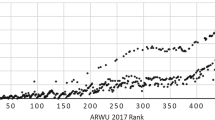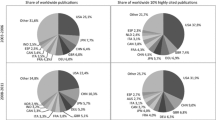Abstract
This study identifies the top 1% of highly-cited researchers at non-Research colleges and universities in the United States and explores the attributes of these researchers and their institutions that help predict their success. Data for the non-Research schools was collected from the National Center of Education Statistics, while citation data were collected via Google Scholar. The findings of this study indicate that, though faculty employed at public institutions outnumber those at private schools, there are roughly equal numbers of highly-cited researchers at both types of institutions. Large universities are responsible for producing more highly-cited researchers than smaller schools, though small schools outnumber large ones. West coast and Northeast institutions produce an outsized number of highly-cited researchers compared to the Midwest and South. Gender and discipline are the strongest predictors of highly-cited researchers, where men strongly outnumber women and researchers in natural science disciplines outnumber those in the social sciences and humanities. These findings may be helpful in identifying the most prolific non-Research institutions in terms of research productivity and acclaim, as well as increasing understanding of attributes that relate to an increased number of highly-cited researchers.
Similar content being viewed by others
References
Batista, P. D., Campiteli, M. G., Kinouchi, O., & Martinez, A. S. (2006). Is it possible to compare researchers with different scientific interests? Scientometrics, 68(1), 179–189.
Bornmann, L., & Bauer, J. (2015). Which of the world’s institutions employ the most highly cited researchers? An analysis of the data from highlycited.com. Journal of the Association for Information Science and Technology, 66(10), 2146–2148.
Bornmann, L., Bauer, J., & Haunschild, R. (2015). Distribution of women and men among highly cited scientists. Journal of the Association for Information Science and Technology, 66(12), 2715–2716.
Boyack, K. W., Klavans, R., Sorensen, A. A., & Ioannidis, J. P. (2013). A list of highly influential biomedical researchers, 1996–2011. European Journal of Clinical Investigation, 43(12), 1339–1365.
Clarivate Web of Science (2022). Highly cited researchers. Retrieved from https://recognition.webofscience.com/awards/highly-cited/2021/
Cohn, S. (2022, July 14). These 10 states are America’s worst places to live in 2022. Retrieved from https://www.cnbc.com/2022/07/14/these-10-states-are-americas-worst-places-to-live-in-2022.html
Docampo, D., & Cram, L. (2019). Highly cited researchers: A moving target. Scientometrics, 118, 1011–1025.
Dundar, H., & Lewis, D. R. (1998). Determinants of research productivity in higher education. Research in Higher Education, 39(6), 607–631.
Hirsch, J. E. (2005). An index to quantify an individual’s scientific research output. Proceedings of the National Academy of Sciences, 102(46), 16569–16572.
Ivanovic, D., & Ho, Y. (2016). Highly cited articles in the Information Science and Library Science category in Social Science Citation Index: A bibliometric analysis. Journal of Librarianship and Information Science, 48(1), 36–46.
Ju, M. (2010). The impact of institutional and peer support on faculty research productivity: A comparative analysis of research vs. non-research institutions (doctoral dissertation). South Orange, NJ: Seton Hall University.
King, D. A. (2004). The scientific impact of nations. Nature, 430, 311–316.
Kosar, R., & Scott, D. W. (2018). Examining the Carnegie Classification methodology for research universities. Statistics and Public Policy, 5(1), 1–12.
Levine-Clark, M., & Gil, E. L. (2021). A new comparative citation analysis: Google Scholar, Microsoft Academic, and Web of Science. Journal of Business and Finance Librarianship, 26(1/2), 145–163.
Lillquist, E., & Green, S. (2010). The discipline dependence of citation statistics. Scientometrics, 84, 749–762.
MacRoberts, M. H., & MacRoberts, B. R. (1996). Problems of citation analysis. Scientometrics, 36, 435–444.
Martinez, R. S., Floyd, R. G., & Erichsen, L. W. (2011). Strategies and attributes of highly productive scholars and contributors to the school psychology literature: Reocmmendations for increasing scholarly productivity. Journal of School Psychology, 49(6), 691–720.
McLendon, M. K., Mokher, C. G., & Doyle, W. (2009). ‘Privileging’ public research universities: An empirical analysis of the distribution of state appropriations across research and non-research universities. Journal of Education Finance, 34(4), 372–401.
Najman, J. M., & Hewitt, B. (2003). The validity of publication and citation counts for sociology and other selected disciplines. Journal of Sociology, 39(1), 62–80.
National Center for Education Statistics (2021a). Integrated postsecondary education data system. Retrieved from https://nces.ed.gov/ipeds/
National Center for Education Statistics (2021b). Historically Black colleges and universities. Retrieved from https://nces.ed.gov/fastfacts/display.asp?id=667
Parker, J., Lortie, C., & Allesina, S. (2010). Characterizing a scientific elite: The social characteristics of the most highly cited scientists in environmental science and ecology. Scientometrics, 85(1), 129–143.
Perry, M., & Reny, P. J. (2016). How to count citations if you must. American Economic Review, 106(9), 2722–2741.
Shaw, D. (2021). Research vs. teaching universities: Differences, pros and cons. Retrieved from https://collegeuncharted.com/research-vs-teaching-universities-differences-pros-and-cons/
Slyder, J. B., Stein, B. R., Sams, B. S., Walker, D. M., Beale, B. J., Feldhaus, J. J., & Copenheaver, C. A. (2011). Citation pattern and lifespan: A comparison of discipline, institution, and individual. Scientometrics, 89, 955–966.
Sugimoto, C. R., Ni, C., & Lariviere, V. (2015). On the relationship between gender disparities in scholarly communication and country-level development indicators. Science and Public Policy, 42(6), 789–810.
The Carnegie Classification of Institutions of Higher Education (2022). Basic classification description. Retrieved from https://carnegieclassifications.acenet.edu/classification_descriptions/basic.php
Townsend, B. K., & Rosser, V. J. (2007). Workload issues and measures of faculty productivity. Thought and Action, 23(1), 7–19.
United States Census Bureau (2021). Census regions and divisions of the United States. Retrieved from https://www2.census.gov/geo/pdfs/maps-data/maps/reference/us_regdiv.pdf
Wei, Y., & He, S. (2021). The characteristics of highly cited researchers in China. iSchools Conference 2021. Retrieved from http://hdl.handle.net/2142/109688
Zhang, X., Estoque, R. C., Xie, H., Murayama, Y., & Ranagalage, M. (2019). Bibliometric analysis of highly cited articles on ecosystem services. PLoS One. https://doi.org/10.1371/journal.pone.0210707
Author information
Authors and Affiliations
Corresponding author
Ethics declarations
Conflicts of Interest
The author has no declarations or conflicts of interest.
Additional information
Publisher’s Note
Springer Nature remains neutral with regard to jurisdictional claims in published maps and institutional affiliations.
Full list of 1388 highly-cited researchers (as of January 2022) available at: https://dx.doi.org/10.13140/RG.2.2.31532.74885
Rights and permissions
Springer Nature or its licensor holds exclusive rights to this article under a publishing agreement with the author(s) or other rightsholder(s); author self-archiving of the accepted manuscript version of this article is solely governed by the terms of such publishing agreement and applicable law.
About this article
Cite this article
Lund, B.D. Highly-Cited Researchers at Non-Research Colleges and Universities in the United States: Prolific Schools, Top Researchers, and Their Attributes. Innov High Educ 47, 1025–1041 (2022). https://doi.org/10.1007/s10755-022-09626-5
Accepted:
Published:
Issue Date:
DOI: https://doi.org/10.1007/s10755-022-09626-5




